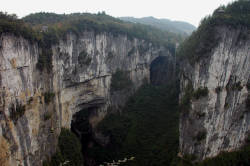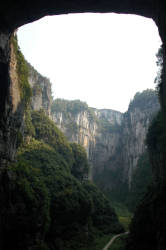天生三桥
Tiānshēng Sān Qiáo - Three Natural Bridges
Useful Information
| Location: |
Wulong
(29.439587, 107.791391) |
| Open: |
All year daily . [2021] |
| Fee: |
. [2021] |
| Classification: |
 Tiankeng Tiankeng
|
| Light: | n/a, you may bring torch |
| Dimension: |
L=12 km, H=300 m. Tianlong Bridge: HS=235 m, T=150 m, L=147 m, H=96 m, W=34 m Qinglong Bridge: HS=281 m, T=168 m, L=124 m, H=103 m, W=31 m Heilong Bridge: HS=223 m, T=107 m, L=193 m, H=116 m, W=28 m HS height surface to floor. T: thickness of rock. |
| Guided tours: | self guided, L=8 km, D=3 h. |
| Photography: | allowed |
| Accessibility: | no |
| Bibliography: | |
| Address: | Three Natural Bridges. |
| As far as we know this information was accurate when it was published (see years in brackets), but may have changed since then. Please check rates and details directly with the companies in question if you need more recent info. |
|
History
| OCT-2003 | Wulong Karst declared a National GeoPark. |
| 2007 | inscribed on the UNESCO World Heritage List. |
Description


天生三桥 (Tiānshēng Sān Qiáo, Three Natural Bridges) is officially named 武隆天生三桥景区 (Wulong Tiansheng Three Bridges Scenic Area). It is a roofless cave, which is not completely roofless, the remaining sections of the cave forming natural bridges. Or, if you look at it from a slightly different angle, there are two tiankeng and two gorges, separated by three natural bridges. The bridges are 天龙桥 (Tianlong qiao, Sky Dragon Bridge), 青龙桥 (Qinglong qiao, Green Dragon Bridge), and 黑龙桥 (Heilong qiao, Black Dragon Bridge). The tiankengs are called 青龙天坑 (Qinglong Tiankeng) and 神鹰天坑 (Shenying Tiankeng). This is called the largest natural bridge group in Asia.
There are two parking lots at the two ends and a trail from one end to the other on the floor of the gorge. On the entrance side in the west, which is located at the first bridge, an glass elevator brings visitors down the vertical cliff section of the tiankeng. It ends at the top of the debris and the trail winds down the slope in serpentines. Then you walk through the gorge downstream to a set of buildings which resembles an ancient monastery. Now you can leave the gorge with a cable car, or you continue walking downstream. Finally, you reach the other end where you are either picked up by your tour operator or take the shuttle back to the entrance.
The whole system was created by 羊水河 (Yangshui River) which flows on the surface, until it reaches the limestone area. Here it went underground and formed a huge cavern, and finally reappeared on the other side of the limestone area where it reappeared in a huge resurgence and again formed a wide valley. But due to the enormous size of the cave passage, an underground canyon with 100 to 150 m height, and the dissolution of the rock above, the ceiling started to vanish. The current situation is a narrowing gorge which ends at the first natural bridge, tiankeng, natural bridge, tiankeng, natural bridge, narrow gorge, which finally opens up at the other end. The Chinese call this 三桥夹两坑 (Three bridges sandwiching two pits).
The building in the 天生三硚 (Tiankeng San Qiao) is called 天福客栈 (Tiānfú kèzhàn, Sky Blessing Inn). It is not ancient, it was erected twenty years ago as a film set for the movie Curse of the Golden Flower (2006). According to rumours the Tang-style buildings cost millions. The dramatic gorge was the location for numerous chinese and a few international films, also for numerous chinese tv series. The most famous was probably Transformers: Age of Extinction (2014).
Be careful when you read about this site on webpages. It is often mixed up with nearby Qingkou Tiankeng Group, which is a group of four tiankengs connected by natural bridges. Erwang Cave is also on the other site.
- See also
 Subterranean World Heritage List
Subterranean World Heritage List Search DuckDuckGo for "Three Natural Bridges"
Search DuckDuckGo for "Three Natural Bridges" Google Earth Placemark
Google Earth Placemark Three Natural Bridges - Wikipedia (visited: 27-AUG-2021)
Three Natural Bridges - Wikipedia (visited: 27-AUG-2021) South China Karst - UNESCO World Heritage List
South China Karst - UNESCO World Heritage List The tour of Chongqing — Wulong Sanqiao natural bridges cave slit Chongqing Travel Guide (visited: 28-AUG-2021)
The tour of Chongqing — Wulong Sanqiao natural bridges cave slit Chongqing Travel Guide (visited: 28-AUG-2021)
 Index
Index Topics
Topics Hierarchical
Hierarchical Countries
Countries Maps
Maps